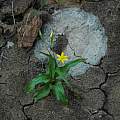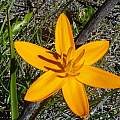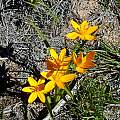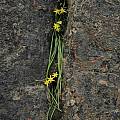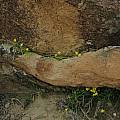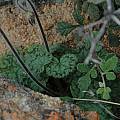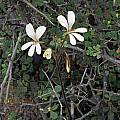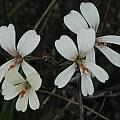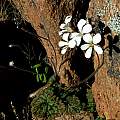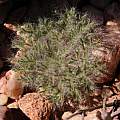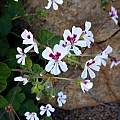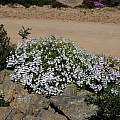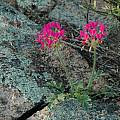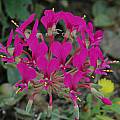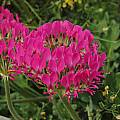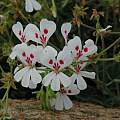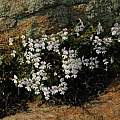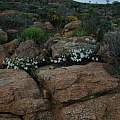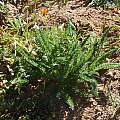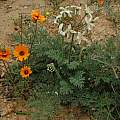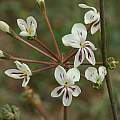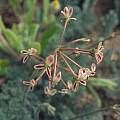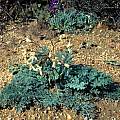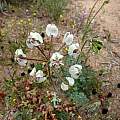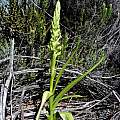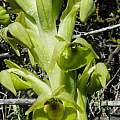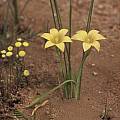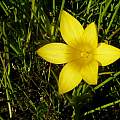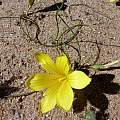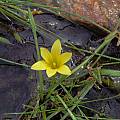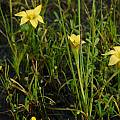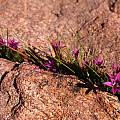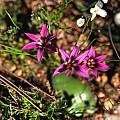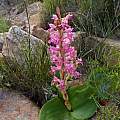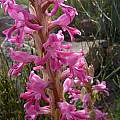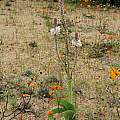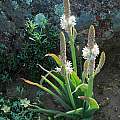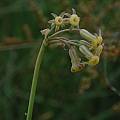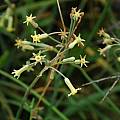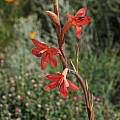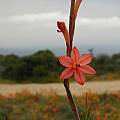Namaqualand is an arid area in northwest South Africa. Although it is a winter rainfall area, rainfall is sparse and the plants found in this area are not included in some of the books illustrating South African bulbs since it is not considered to be part of the Cape Floral province. For most of the year the land appears to be a desert and because it has an average annual rainfall of 50-400 mm it could be classified as such. But in a year with adequate rainfall it becomes alive with an amazing floral display of annuals, bulbs, dwarf shrubs, and succulents. Flowering usually occurs in August and September, but dry winds which halt the display can end it sooner. In a year with little rainfall there are few flowers. Summers are hot and dry but there is occasional fog since the ocean is not that far away. Photos on this page were taken in Namaqualand. More information about the plants seen on this page can be found on the wiki genus pages. Links are included to make it easier to go directly to these pages. Species P through W, Pauridia through Watsonia, are pictured below.
Pauridia gracilipes ssp. gracilipes was formerly considered to be a yellow flowered Spiloxene ovata. The photo was taken by Mary Sue Ittner September 2006.
Pauridia gracilipes ssp. speciosa is endemic to the Kamiesberg and has flowers that are pale to deeper orange. Photos taken by Cameron McMaster in
Pauridia scullyi, syn. Spiloxene scullyi, photos taken September 2006 by Bob Rutemoeller.
Pelargonium barklyi is native to the Northwestern Cape of South Africa. It grows from a large tuber and produces large heart-shaped hairy leaves with purple zones during the winter months followed by cream flowers held aloft on long petioles which appear at the end of the winter and in early spring. The first three photos were taken September 2006 in Namaqua National Park by Bob Rutemoeller and Mary Sue Ittner. The leaves were protected below a shrub. And the flowers twined through the leaves and branches of the shrub. The last photo was taken near Kamieskroon by Cameron McMaster.
Pelargonium caroli-henrici B. Nord. is a tuberous species from the west coast of South Africa, from the lowland quartzite areas of the Knersvlakte, from Garies to Koekenaap. The photo from iNaturalist was taken by Nick Helme in Namaqualand in August and shared under a CC BY-SA license.
Pelargonium echinatum Curtis is a branched shrub with a tuber. It is found on stony slopes in Namaqualand southwards to Clanwilliam in the Western Cape. Photos were taken by Cameron McMaster near Kamiestroon and Spoegrivier.
Pelargonium incrassatum is native to the Northwestern Cape where it is found in elevated mountainous areas and their foothills, sometimes in areas with very little rainfall and sometimes in areas with more. Photos were taken in September 2006 by Bob Rutemoeller.
Pelargonium moniliforme Harv. is a tuberous species from the West Coast of South Africa, from the Southwest corner of the Richtersveld to Karoo Poort in the South and Matjiesfontein in the East. It grows in sand or in clay, on quartzite outcrops and stony areas. Photos were taken in Namaqualand by Bob Rutemoeller and Mary Sue Ittner.
Pelargonium rapaceum (L.) L'Hér. is a species with the widest South African distribution of all those species in Section Hoarea, from the Richtersveld, along the West coast on the coastal plain and then along the south coast as far as Grahamstown, on fynbos, renosterveld and marginal strandveld. The photo was taken by Cameron McMaster.
Pelargonium triste grows on sandy flats and lower slopes in Namaqualand and over a broad region of the Western Cape and also can be found in flower over a long period (August to February). The first four photos were taken by Bob Rutemoeller and Mary Sue Ittner on two different trips. The last photo was taken near Naries by Cameron McMaster.
Pterygodium hallii photos taken by Cameron McMaster near Kamieskroon.
Romulea citrina habitat photos from Rod Saunders, Cameron McMaster and Mary Sue Ittner. The last two taken in Namaqualand September 2006 show it growing in some wet spots.
Romulea kamisensis Photos taken on two different trips (2001, 2006) by Mary Sue Ittner and Bob Rutemoeller.
Romulea namaquensis photographed by Mary Sue Ittner in 2001 growing with Lapeirousia silenoides.
Satyrium erectum Sw. is a widespread winter rainfall species found on dry sandstone, and clay flats from Namaqualand to the southwestern Eastern Cape. Photos were taken by Cameron McMaster near Springbok.
Trachyandra falcata Photos taken by Mary Sue Ittner September 2006.
Tulbaghia dregeana Photos were taken by Bob Rutemoeller and Mary Sue Ittner in September 2006.
Watsonia meriana Photos were taken by Mary Sue Ittner September 2006.
Namaqualand A-F - Namaqualand G-I - Namaqualand L-M - Namaqualand O - Namaqualand Index
